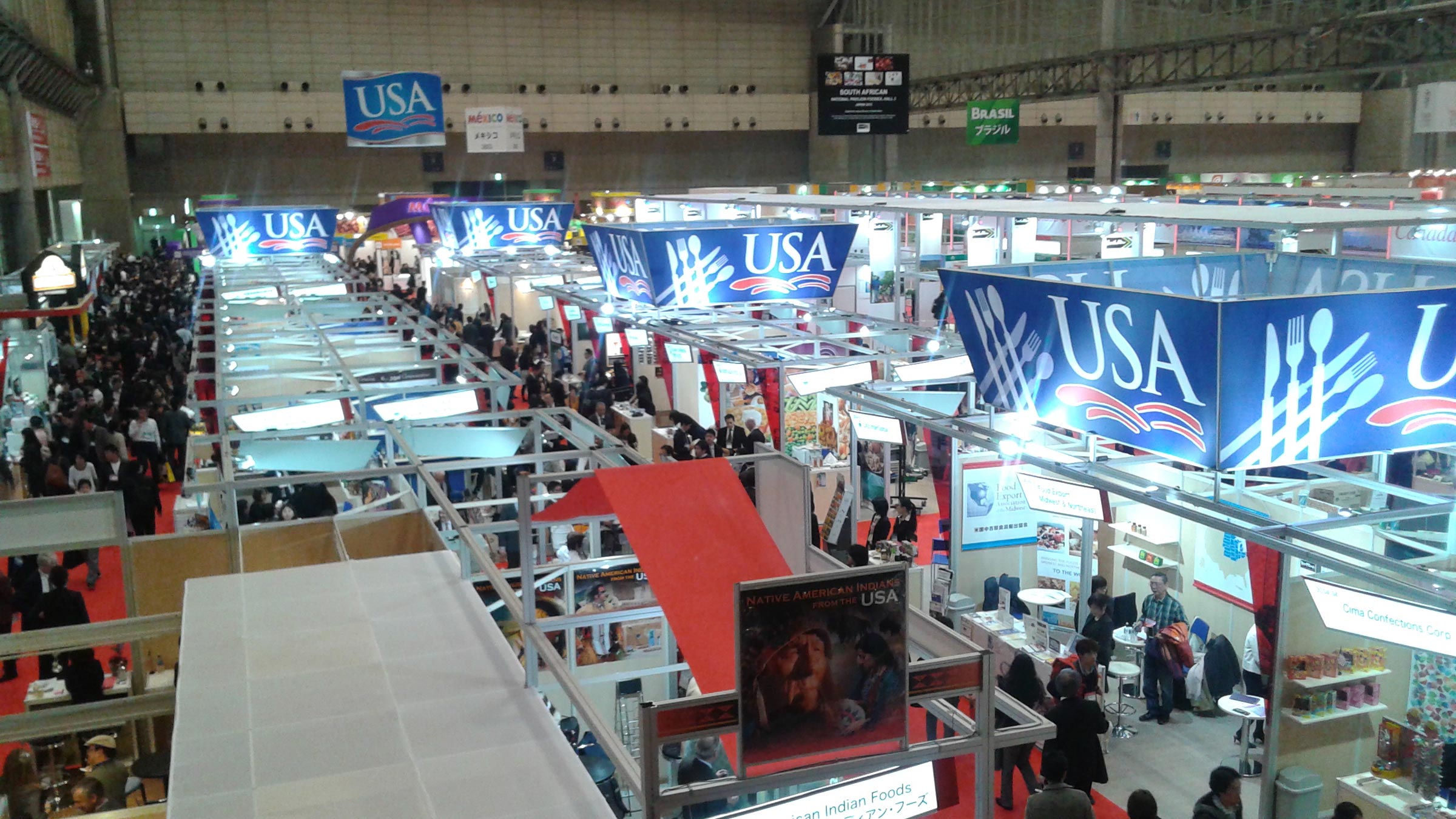
COUNTRY PROFILE
Discover more about the Thailand market including overviews about the retail, foodservice, and food-processing sectors. Events, resources, and more are linked throughout the profile.

$358 million
total U.S. processed food exports to Thailand in 2023

6th
largest importer of U.S. processed foods in the region

69.7 million
total population in 2023
Euromonitor reports that Thailand’s economy recovered to its pre-pandemic level in 2022, with private consumption and the tourism sector continuing to drive growth. Despite persisting global pressures, inflation is forecast to contract over the medium term. Exports remain a key element of the Thai economy, while the country is set to benefit from the Regional Comprehensive Economic Partnership (RCEP) agreement, promoting supply chain diversification. Thailand experienced a solid increase in foreign direct investment (FDI) in 2022, despite global economic headwinds.
The increase in inflation witnessed in Thailand in 2022 was mainly caused by a global imbalance of supply and demand, along with the high prices of energy, food, and other commodities after the COVID-19 pandemic and Russia’s invasion of Ukraine. This rise in inflation led to increased costs for businesses and reduced the purchasing power of consumers by eroding their real income gains. The categories of transport, clothing and footwear, and food and non-alcoholic beverages saw the biggest price hikes among major groups of consumer goods and services in Thailand during the year. Despite the surge in 2022, inflation should continue on a general downtrend over the forecast period, reaching 1.5% by 2027.
Thailand currently has free trade agreements with the Association of Southeast Asian Nation countries (ASEAN), Australia-New Zealand, China, India, Japan, Peru, South Korea, and Chile. Thailand has been in negotiations for bilateral free trade arrangements with the European Union, Pakistan, Sri Lanka, and Turkey. On November 15, 2020, Thailand, which is an ASEAN member, officially signed the Regional Comprehensive Economic Partnership (RCEP) agreement with five other countries in the Asia Pacific region, consisting of Australia, China, Japan, New Zealand, and South Korea. The free trade agreement went into effect in January 2022.
An aging population could slow economic growth in the longer term. Thailand is one of the world’s poorest countries to face the phenomenon of aging. The country’s workforce is already beginning to contract as a result, creating pressure to improve productivity if Thailand is to continue to grow.
Thailand’s population was 69.7 million in 2023, (CIA World Factbook Est.) an increase of 9.1 million since 2000. Growth of population has been relatively rapid in recent decades but is decelerating. The slowdown means the country’s pool of young workers will shrink in the medium term. The median age in 2023 was 41 years, up from 30.2 years in 2000. The median age will reach 50 years in 2030. The number of elderly (those over 65 years) was 14.5% of the total in 2023 but their number will increase significantly by 2030 when this group will represent 17.6% of total population.
The USDA Office of Agricultural Affairs, OAA, in Bangkok, hereinafter referred to as FAS Post Bangkok, reports that Thailand is Southeast Asia’s second largest economy. Thailand remains a strong agricultural competitor as it is the world’s leading exporter of natural rubber, frozen shrimp, canned tuna, canned pineapples, cooked poultry, and cassava. It is also a major exporter of sugar and rice.
Thailand is the sixth largest importer of U.S. processed foods in the region, totaling US$490 million in 2022, and growth of 1%. In 2023 U.S. processed food exports to Thailand have declined a staggering 27% to US$358 million. This is a loss of US$131 million which adds to the U.S trade deficit in the export of food and agricultural products.
Top U.S. processed food exports to Thailand in 2023 included:

$16.3 billion
estimated total value of retail sales of packaged foods in 2023

24.6%
increase in retail sales value of packaged foods since 2019

$23.5 billion
projected value of packaged food retail sales by 2028
Euromonitor has estimated the retail sales value of packaged foods in Thailand at US$16.3 billion in 2023. This represents an increase of 24.6% or US$3.4 billion since 2019. They have also forecast the packaged food retail sales to reach US$23.5 billion by 2028, an increase of 32.2% or US$5.1 billion from 2024.
High growth products in the forecast include:
FAS Post Bangkok reports that the Thai Retailers Association forecasts that Thailand’s retail sector will grow 6%-8% in 2023 as the tourism sector recovers. The food and beverage industry is one of the largest retail segments in Thailand. The country’s economic growth, coupled with higher disposable incomes in the middle-income
population, a greater propensity to spend, and a trend towards urbanization, fueled the growth in the retail sector prior to the pandemic. Changes in the structure of Thai households and the pandemic have led to changes in how Thais eat, with a rising demand for convenient ready-to-eat meals, healthy food products, and food delivery.
Retailers have improved and developed their supply chain systems to strengthen their capacity to source and supply products during the pandemic. Most retailers, especially supermarkets, hypermarkets, and cash and carry, are offering a wide range of value-added fresh food to meet customers’ needs, including marinated, ready-to-cook, ready-to-eat meals, and plant-based foods and beverages. The pet food market also holds good prospects for U.S. exporters due to the increasing number of pet owners in Thailand. As the purchasing power of Thai consumers has notably increased in recent years and the financial situation of the middle class has improved, sales turnover has raised significantly, even in the premium and super premium segments.
The overall landscape in the Thai retail business remains competitive. There are several well-established players in the modern trade retail market. There are three major conglomerates dominating the Thai retail market (i.e., Central Group, TCC Group, and CP Group). Central Group owns Tops Foodhall and Tops Market supermarket chains. The TCC Group which also has Thai Beverage owns Big C. The CP Group runs 7-Eleven, a convenient store chain with over 13,000 outlets, Makro, a cash-and-carry store, and Lotus’s, which is one of the only two major hypermarket retailers in Thailand.
The convenience store sector has experienced continuous growth in comparison to other retail formats. Thailand has a total of 21,548 stores nationwide, with 1,225 stores opening in 2022. Demand for convenient, inexpensive, and time-efficient foods has increased significantly due to changes in Thai society. Food and beverage products account for approximately 74% of all products sold in convenience stores including ready-to-eat meals, fruits, baked goods, a variety of snacks, desserts, coffee, beverages, and other confectionaries. Convenience store operators have also increased healthy food assortments such as ready-to-eat fresh fruits and vegetables, fruit and vegetable juices, functional drinks, low-calorie foods, and healthy snacks to accommodate the need and growth of health conscious and aging customers. On average, over 12 million customers shop at convenience stores nationwide per day in 2022.
7-Eleven also arranges vending machines that sell food, beverages, and non-food products in some areas that are not suitable for a store. In 2022, the company had over 4,200 vending machines nationwide. 7-Eleven also arranges coffee and mini kitchen corners to sell beverages including coffee and tea, freshly baked products, or prepared food, such as freshly baked pizza and non-coffee drinks, such as smoothies and freshly squeezed juices. Another example of a new trend that is well-received by customers are collaborations of well-known restaurants and famous chefs to produce new ready-to-eat meals.
Hypermarkets and “cash & carry” establishments present good opportunities for U.S. exporters of fresh and frozen food, beverage products, and products that cater to mainstream consumers. Cash and carry retailers’ target customers are small- to medium- sized grocery shops, hotels, restaurants, caterers, and other foodservice operators. The product mix strategy for both hypermarket and cash & carry is to focus on fresh food by increasing fresh food sales space and product ranges. Makro, which is a cash and carry retailer, imports and distributes frozen and chilled food with delivery services.
Lotus’s and Big C offer a wide range of products including a wide selection of imported foods targeted at middle income customers. Makro is a membership-based cash and carry retailer. Its target groups are small- and medium-sized businesses including grocery shops, hotels, restaurants, catering, culinary institutions, and food business services providers. Siam Makro also has its own import division, which delivers frozen imported and local food products such as American fries, cheese, and frozen seafood.
FAS Post Bangkok reports that the best product prospects for U.S. suppliers include Major consumer-oriented products from the U.S. States to Thailand include almonds, pistachios, walnuts, raisins, food preparation ingredients, whey, milk and cream, frozen potatoes, cheese, popcorn, apples, grapes, cherries, strawberries, cocoa preparations, beef, seafood, wines, and pet food.

$30.6 billion
estimated foodservice market size by the end of 2023

$47.8 billion
Thailand’s projected foodservice market size by 2029

80%
of Thailand’s food franchises are partnerships with U.S. brands and other foreign brands
FAS Post Bangkok reports that The Kasikorn Research Center and Euromonitor estimate Thailand’s foodservice market size at US$30.6 billion by the end of 2023 and project it to reach $47.8 billion by 2029. Thailand’s new government took office in September of 2023 and promised to institute policies to support small- and medium-sized enterprises (SMEs), reduce agricultural production costs, and promote international tourism with visa-free programs for certain countries. The foodservice sector likely stands to gain from the new government’s focus on trade and economic growth. The positive outlook for the HRI sector is buoyed by a “return to normal” behavior of Thai consumers along with a rapidly recovering tourism sector. In 2023, foodservice operators launched numerous new marketing activities, innovative business models, and revamped menu selections.
Franchises that sell chicken, burgers, bakery products, pizza, ice-cream, and breakfast meals dominate the Quick Service Restaurant (QSR) sector. Given Thailand’s 2022 per capita consumption of nearly 22 kilograms of chicken and pork products, the preference for chicken and pork-based fast food is driving the expansion of QSRs in Thailand. Approximately 80% of Thailand’s food franchises are partnerships with U.S. brands (e.g., McDonald’s, KFC, Pizza Hut, Taco Bell, Domino Pizza, Au Bon Pain, Starbucks, Carl’s Junior, Shake Shack, Burger King, Baskin-Robbins, Dairy Queen, Auntie Anne’s, and Subways) and other foreign brands (e.g., Mos Burger, Bonchon Chicken, Yoshinoya, and Chabuton Ramen).
Full-service restaurants (FSRs) represent about 15% of all restaurants in Thailand. FSRs focusing on Asian cuisines (e.g., Chinese, Korean and Japanese) are most in-demand. The hot pot and barbeque grill dining trends have been gaining popularity and are key drivers in the growth of the restaurant sector. Other popular cuisines include Italian and American. The high-end or fine dining restaurants that offer unique food and dining experiences also have become significant players in the restaurant sector. Many of the high-end fine dining establishments, especially the Michelin-listed restaurants (e.g., Le Normandie, Sorn, Sühring, Le Du, and Baan Tepa) generate substantial revenue for the country.
FAS Post Bangkok reports that the HRI sector sources about 30%-35% of its food products through imports. In 2022, Thailand imported US$485 million (or approximately 6%) in U.S. consumer-oriented food exports. HRI foodservice operators regularly import U.S. beef, seafood, cheese, frozen potatoes, seasonings, fresh fruits, dried fruits, nuts, bakery fillings, fruit juice, juice concentrate, wines, craft beer, and health and wellness products. Food preparation and ready-to-eat meals continue to be key products for HRI establishments accommodating both delivery services and small food outlets.

$3.3 billion
total value of Thailand’s imports of food ingredients in 2022

$39 billion
total value of Thailand’s food exports in 2022
FAS Post Bangkok reports that Thailand’s food processing industry is among the most developed in Southeast Asia. There are many medium-to-large food processors that produce high-value products for domestic and export markets. Thailand aims to be one of the world’s top 10 processed food exporters by 2027 and a key global player in the “Future Food” market. The value of Thailand’s food exports was approximately $39 billion in 2022, while the value of Thailand’s imports of food ingredients reached $3.3 billion. With rising demand for processed foods, Thai food processors must import large quantities of food ingredients that are not locally available.
Major food exports include rice, canned tuna, sugar, meat, cassava products, and canned pineapple. The value of Thailand’s food exports was US$38.8 billion in 2022, while the value of Thailand’s imports of food ingredient was US$3.3 billion. With rising demand for processed foods and new product development, there are significant opportunities for U.S. food ingredients to in the Thai food processing sector.
Thailand’s food processing industry has developed rapidly over the past decade and is one of the most developed in Southeast Asia. Most food processors are small- to medium-sized and predominantly serve the domestic market. However, there are many medium-to-large food processors that produce higher-value products for domestic and export markets.
FAS Post Bangkok reports that products present in the market that have good sales potential include healthy and functional food ingredients including dried fruits, nuts, pulses, plant-based proteins (e.g., soybean, nuts, and pulses), dairy proteins, nutrients, vitamins, minerals, prebiotics, probiotics, dietary fiber, essential oils, and collagen. There is also a growing demand for organic, gluten-free, plant-based, herbal extracts, immune boosting food ingredients, and sweeteners used in non-alcoholic beverages and the confectionery industry. Beverage manufacturers are reducing sugar content to minimize the impact from the excise tax. Fish fillets for processed seafood, frozen food, and ready-to-eat products also have good sales potential.
